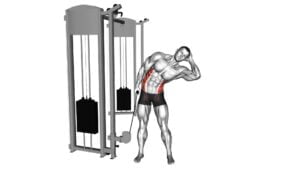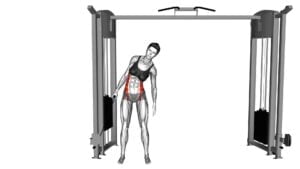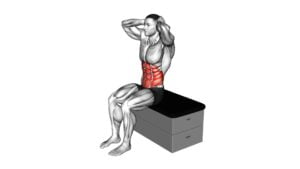Cable Side Bend – Video Exercise Guide & Tips

Get ready to tone your obliques with the cable side bend!
Watch This Exercise Video
This video exercise guide and tips will show you the proper form and variations of this effective move.
Avoid common mistakes and maximize your results with these expert tips.
Grab the equipment and get ready to sculpt those abs.
Let's dive in and get those side muscles working!
Key Takeaways
- Cable side bend targets obliques, transverse abdominis, and erector spinae.
- Proper form includes maintaining a neutral spine, controlling the movement, and engaging the core throughout.
- Cable side bend can be modified with lighter weights or performed seated for increased challenge.
- Variations of cable side bend, such as single-arm cable side bend and cable side bend with rotation, provide additional challenges and target different muscles.
Benefits of Cable Side Bend
Get more out of your cable side bend exercise by understanding the benefits it offers for your core strength and stability. Cable side bend variations can target different muscles within your core, including your obliques, transverse abdominis, and erector spinae. By incorporating these variations into your routine, you can challenge your core muscles in new ways and prevent plateauing.
One of the main benefits of cable side bends is that they help improve your core strength. The resistance provided by the cable forces your core muscles to work harder to stabilize your body during the movement. This increased resistance leads to stronger core muscles over time.
Another benefit of cable side bends is improved stability. As you perform the exercise, you engage your core muscles to maintain proper alignment and balance. This not only helps with your overall stability but also enhances your ability to perform other exercises and everyday activities.
Incorporating cable side bends into your workout routine can also help with functional movements. The twisting motion involved in this exercise mimics movements you may encounter in daily life, such as reaching for objects or twisting to pick something up. By strengthening your core through cable side bends, you can improve your ability to perform these movements safely and efficiently.
Now that you understand the benefits of cable side bends, let's move on to discussing the proper form for this exercise.
Proper Form for Cable Side Bend
To perform the cable side bend exercise correctly, start by standing tall with your feet shoulder-width apart and gripping the cable handle with one hand. Here's how to ensure proper form for the cable side bend:
- Keep your core engaged: Contract your abdominal muscles throughout the movement to stabilize your spine and protect your lower back.
- Maintain a neutral spine: Avoid rounding or arching your back. Keep your spine in a straight line from your head to your tailbone.
- Control the movement: Slowly bend your torso to the side, focusing on the contraction of your oblique muscles. Avoid using momentum or swinging your body.
Proper breathing technique is also essential during the cable side bend exercise. Exhale as you bend your torso to the side, and inhale as you return to the starting position. This helps engage your core and maintain stability throughout the exercise.
If you're looking to modify the cable side bend, you can try using lighter weights or resistance bands. This allows for easier progression and reduces the risk of injury. Additionally, you can perform the exercise seated on a bench or stability ball to further challenge your core stability.
Equipment Needed for Cable Side Bend
To perform the cable side bend exercise, you'll need the following equipment. First and foremost, you'll need a cable machine. This machine consists of a weight stack and a pulley system that allows you to adjust the resistance. It's important to choose a weight that challenges you without compromising your form.
Additionally, you'll need an attachment for the cable machine. The most commonly used attachment for the cable side bend is the D-handle. This handle allows for a comfortable grip and smooth movement during the exercise.
Having the proper equipment is crucial for performing the cable side bend exercise effectively and safely. Using alternatives such as resistance bands or dumbbells may not provide the same level of resistance or stability as the cable machine. Therefore, it's recommended to use the cable machine for this exercise to ensure optimal results.
Now that you know the equipment needed for the cable side bend, let's move on to discussing the variations of this exercise.
Variations of Cable Side Bend
After discussing the equipment needed for the cable side bend, let's now explore the various variations of this exercise. There are several cable side bend variations that you can incorporate into your workout routine to target different muscle groups and add variety to your workouts. Here are three variations to try:
- Single-arm cable side bend: Instead of using both arms, perform the cable side bend with just one arm. This variation adds an extra challenge to your core muscles as they've to work harder to stabilize your body.
- Cable side bend with rotation: Start the cable side bend as usual, but when you reach the top, rotate your torso towards the cable machine. This variation engages your obliques and improves rotational strength.
- Cable side plank: Instead of bending to the side, assume a side plank position with your feet stacked and your body in a straight line. Hold the cable handle with your top hand and lift your hips off the ground. This variation targets your obliques, shoulders, and core stability.
Remember, when performing cable side bend variations, it's important to maintain proper form and technique. Keep your core engaged, maintain a neutral spine, and control the movement throughout.
Now let's move on to the next section to discuss common mistakes to avoid during cable side bend.
Common Mistakes to Avoid During Cable Side Bend
Now let's address some common mistakes that you should avoid when performing the cable side bend exercise.
Proper technique is crucial to ensure that you're targeting the correct muscles and avoiding any potential injuries.
One common error is using too much weight. It's important to start with a lighter weight and gradually increase it as you become more comfortable and confident with the movement.
Another mistake is bending too far to the side. Remember, the goal is to engage your oblique muscles, not to touch your elbow to your thigh. Maintain control and focus on the contraction in your side muscles.
Additionally, avoid twisting your torso or using momentum to complete the exercise. This can lead to strain on your lower back and decrease the effectiveness of the exercise.
Lastly, ensure that you're maintaining proper posture throughout the movement. Keep your chest lifted, shoulders relaxed, and core engaged.
Tips to Maximize Results With Cable Side Bend
To maximize your results with cable side bends, it's crucial to prioritize proper form. Focus on maintaining a neutral spine and engaging your core throughout the exercise.
Additionally, gradually increasing the resistance over time will help you continue challenging your muscles and stimulating growth.
Proper Form Importance
To maximize your results with the cable side bend, it's crucial to maintain proper form. Proper form not only ensures that you're targeting the right muscles, but it also reduces the risk of injury. Here are some tips to help you maintain proper form and get the most out of your cable side bend:
- Keep your core engaged throughout the exercise.
- Stand with your feet shoulder-width apart and knees slightly bent.
- Keep your back straight and avoid leaning forward or backward.
By following these form tips, you'll be able to effectively work your obliques and avoid potential risks.
Now that you understand the importance of technique, let's move on to the next section and discuss how to gradually increase resistance for even better results.
Gradually Increase Resistance
To maximize your results with the cable side bend and continue building upon your progress, it's important to gradually increase resistance while maintaining proper form.
Increasing the difficulty of the exercise by adding more weight or resistance will challenge your muscles and help you continue to make gains. However, it's crucial to do this gradually to avoid injuries.
Adding too much weight too quickly can put excessive strain on your muscles and joints, increasing the risk of strains, sprains, or even more severe injuries. Start by increasing the resistance by small increments, such as adding 5 pounds at a time, and gradually progress from there.
Listen to your body and pay attention to any discomfort or pain. If you feel any, reduce the resistance or take a break to avoid potential injuries.
Frequently Asked Questions
How Many Sets and Reps Should I Do for Cable Side Bends?
To determine the number of sets and reps for cable side bends, it's important to consider your fitness goals and current fitness level.
Proper form and technique are key to maximize the benefits of this exercise.
Cable side bends target the obliques, helping to strengthen and tone your waistline.
Incorporating cable side bends into your workout routine can improve core stability, enhance posture, and increase overall strength.
Consult with a fitness professional to create a personalized plan that fits your needs.
Can I Perform Cable Side Bends if I Have Lower Back Issues?
If you have lower back issues, it's important to be cautious when performing cable side bends. Make modifications to the exercise to avoid exacerbating your condition.
Consult with a qualified fitness professional or physical therapist for guidance on the best modifications for your specific situation.
Cable side bends can be beneficial for incorporating into a rehabilitation program for lower back issues, as they can help strengthen the core and oblique muscles, improving stability and reducing pain.
Is It Necessary to Use a Cable Machine for Cable Side Bends or Can I Use Other Equipment?
To answer your question, using a cable machine for cable side bends offers several benefits.
It provides constant tension throughout the movement, targeting your oblique muscles effectively.
Compared to other equipment options like dumbbells or resistance bands, the cable machine allows for a wider range of motion and better control.
Additionally, the cable machine enables you to adjust the weight and intensity according to your fitness level.
Can I Perform Cable Side Bends as a Standalone Exercise or Should I Incorporate Them Into a Full Workout Routine?
You should definitely incorporate cable side bends into your full workout routine. They offer several benefits such as targeting your oblique muscles, improving core strength, and increasing stability.
To perform cable side bends correctly, stand with your feet shoulder-width apart, grasp the cable handle with one hand, and slowly bend sideways while keeping your core engaged. Make sure to avoid using momentum and focus on controlled movements.
Incorporating cable side bends will add variety and challenge to your workout routine.
Are There Any Alternative Exercises That Target the Same Muscles as Cable Side Bends?
Looking for alternative exercises that target the same muscles as cable side bends? You're in luck! There are several options you can try.
Side plank, Russian twists, and dumbbell side bends are all great alternatives that activate the same muscles. These exercises provide a challenging workout for your obliques and help improve core strength.
Give them a go and see which one works best for you!
Conclusion
In conclusion, cable side bends are an effective exercise for targeting and strengthening the oblique muscles. By maintaining proper form and using the appropriate equipment, you can maximize the benefits of this exercise.
Avoid common mistakes such as using too much weight or leaning too far to one side. By following these tips and consistently incorporating cable side bends into your workout routine, you can achieve optimal results and improve your overall core strength.

Author
Years ago, the spark of my life’s passion ignited in my mind the moment I stepped into the local gym for the first time. The inaugural bead of perspiration, the initial endeavor, the very first surge of endorphins, and a sense of pride that washed over me post-workout marked the beginning of my deep-seated interest in strength sports, fitness, and sports nutrition. This very curiosity blossomed rapidly into a profound fascination, propelling me to earn a Master’s degree in Physical Education from the Academy of Physical Education in Krakow, followed by a Sports Manager diploma from the Jagiellonian University. My journey of growth led me to gain more specialized qualifications, such as being a certified personal trainer with a focus on sports dietetics, a lifeguard, and an instructor for wellness and corrective gymnastics. Theoretical knowledge paired seamlessly with practical experience, reinforcing my belief that the transformation of individuals under my guidance was also a reflection of my personal growth. This belief holds true even today. Each day, I strive to push the boundaries and explore new realms. These realms gently elevate me to greater heights. The unique combination of passion for my field and the continuous quest for growth fuels my drive to break new ground.







